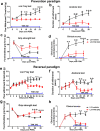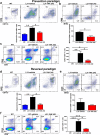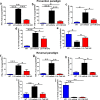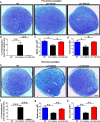Inhibition of TLR4 signaling protects mice from sensory and motor dysfunction in an animal model of autoimmune peripheral neuropathy
- PMID: 33752705
- PMCID: PMC7983271
- DOI: 10.1186/s12974-021-02126-x
Inhibition of TLR4 signaling protects mice from sensory and motor dysfunction in an animal model of autoimmune peripheral neuropathy
Abstract
Background: While the etiology remains elusive, macrophages and T cells in peripheral nerves are considered as effector cells mediating autoimmune peripheral neuropathy (APN), such as Guillain-Barre syndrome. By recognizing both pathogen-associated molecular patterns (PAMPs) and damage-associated molecular patterns (DAMPs) signals, TLRs play a central role in the initiation of both innate and adaptive immune responses. In this study, we aimed to understand the involvement of TLR4 in the pathogenesis of APN and explore the potential of TLR4 as a drug target for therapeutic use.
Methods: APN was induced by a partial ligation on one of the sciatic nerves in B7.2 (L31) transgenic mice which possess a predisposed inflammatory background. APN pathology and neurological function were evaluated on the other non-injured sciatic nerve.
Results: TLR4 and its endogenous ligand HMGB1 were highly expressed in L31 mice, in circulating immune cells and in peripheral nerves. Enhanced TLR4 signaling was blocked with TAK 242, a selective TLR4 inhibitor, before and after disease onset. Intraperitoneal administration of TAK 242 not only inhibited monocyte, macrophage and CD8+ T cell activation, but also reduced the release of pro-inflammatory cytokines. TAK 242 protected mice from severe myelin and axonal loss, resulting in a remarkable improvement in mouse motor and sensory functions. TAK 242 was effective in alleviating the disease in both preventive and reversal paradigms.
Conclusion: The study identified the critical contribution of TLR4-mediated macrophage activation in disease course and provided strong evidence to support TLR4 as a useful drug target for treating inflammatory autoimmune neuropathy.
Keywords: Autoimmunity; CD8+ T cells; DAMPs; Demyelination; Inflammation; Macrophages; TLR4.
Conflict of interest statement
The authors declare no competing financial interests.
Figures







Similar articles
-
CX3CR1 But Not CCR2 Expression Is Required for the Development of Autoimmune Peripheral Neuropathy in Mice.Front Immunol. 2021 Aug 16;12:720733. doi: 10.3389/fimmu.2021.720733. eCollection 2021. Front Immunol. 2021. PMID: 34484228 Free PMC article.
-
Effector/memory CD8+ T cells synergize with co-stimulation competent macrophages to trigger autoimmune peripheral neuropathy.Brain Behav Immun. 2018 Jul;71:142-157. doi: 10.1016/j.bbi.2018.04.001. Epub 2018 Apr 5. Brain Behav Immun. 2018. PMID: 29627532
-
Nanoparticle incorporating Toll-like receptor 4 inhibitor attenuates myocardial ischaemia-reperfusion injury by inhibiting monocyte-mediated inflammation in mice.Cardiovasc Res. 2019 Jun 1;115(7):1244-1255. doi: 10.1093/cvr/cvz066. Cardiovasc Res. 2019. PMID: 30851101
-
TLR2 and TLR4 in autoimmune diseases: a comprehensive review.Clin Rev Allergy Immunol. 2014 Oct;47(2):136-47. doi: 10.1007/s12016-013-8402-y. Clin Rev Allergy Immunol. 2014. PMID: 24352680 Review.
-
Toll-Like Receptor 4 (TLR4)/Opioid Receptor Pathway Crosstalk and Impact on Opioid Analgesia, Immune Function, and Gastrointestinal Motility.Front Immunol. 2020 Jul 8;11:1455. doi: 10.3389/fimmu.2020.01455. eCollection 2020. Front Immunol. 2020. PMID: 32733481 Free PMC article. Review.
Cited by
-
Clavulanic acid prevents paclitaxel-induced neuropathic pain through a systemic and central anti-inflammatory effect in mice.Neurotherapeutics. 2025 Mar;22(2):e00522. doi: 10.1016/j.neurot.2024.e00522. Epub 2025 Jan 9. Neurotherapeutics. 2025. PMID: 39794241 Free PMC article.
-
Monocyte Trafficking and Polarization Contribute to Sex Differences in Meta-Inflammation.Front Endocrinol (Lausanne). 2022 Mar 28;13:826320. doi: 10.3389/fendo.2022.826320. eCollection 2022. Front Endocrinol (Lausanne). 2022. PMID: 35422759 Free PMC article.
-
The Role of Myeloid Differentiation Factor 2 in Stroke: Mechanisms and Therapeutic Potential.Biomolecules. 2025 Jul 4;15(7):961. doi: 10.3390/biom15070961. Biomolecules. 2025. PMID: 40723833 Free PMC article. Review.
-
Remnant Cholesterol and Dyslipidemia Are Risk Factors for Guillain-Barré Syndrome and Severe Guillain-Barré Syndrome by Promoting Monocyte Activation.Front Immunol. 2022 Jul 13;13:946825. doi: 10.3389/fimmu.2022.946825. eCollection 2022. Front Immunol. 2022. PMID: 35911688 Free PMC article.
-
Role of gut-derived bacterial lipopolysaccharide and peripheral TLR4 in immobilization stress-induced itch aggravation in a mouse model of atopic dermatitis.Sci Rep. 2024 Mar 15;14(1):6263. doi: 10.1038/s41598-024-56936-z. Sci Rep. 2024. PMID: 38491103 Free PMC article.
References
MeSH terms
Substances
Grants and funding
LinkOut - more resources
Full Text Sources
Other Literature Sources
Medical
Molecular Biology Databases
Research Materials
Miscellaneous

